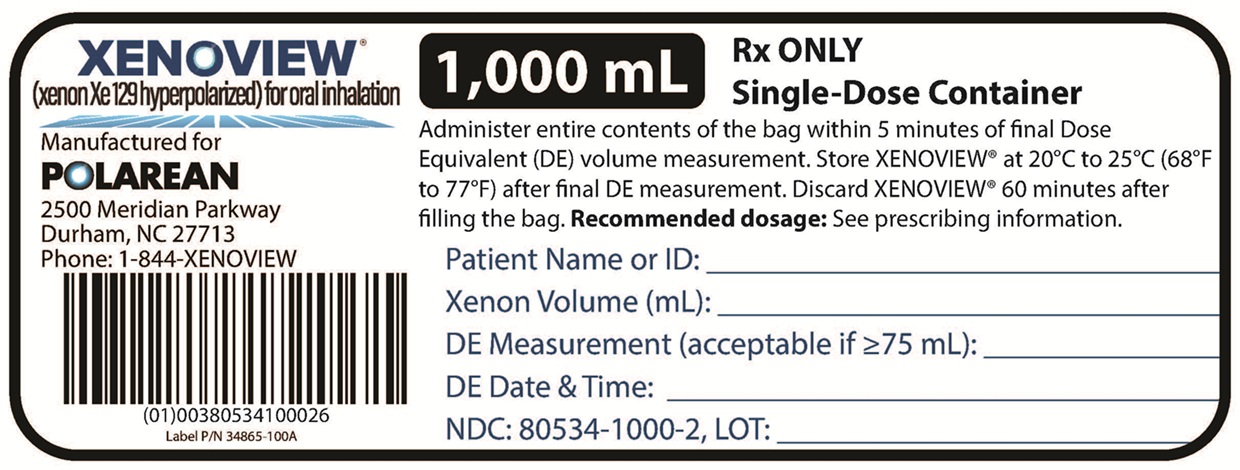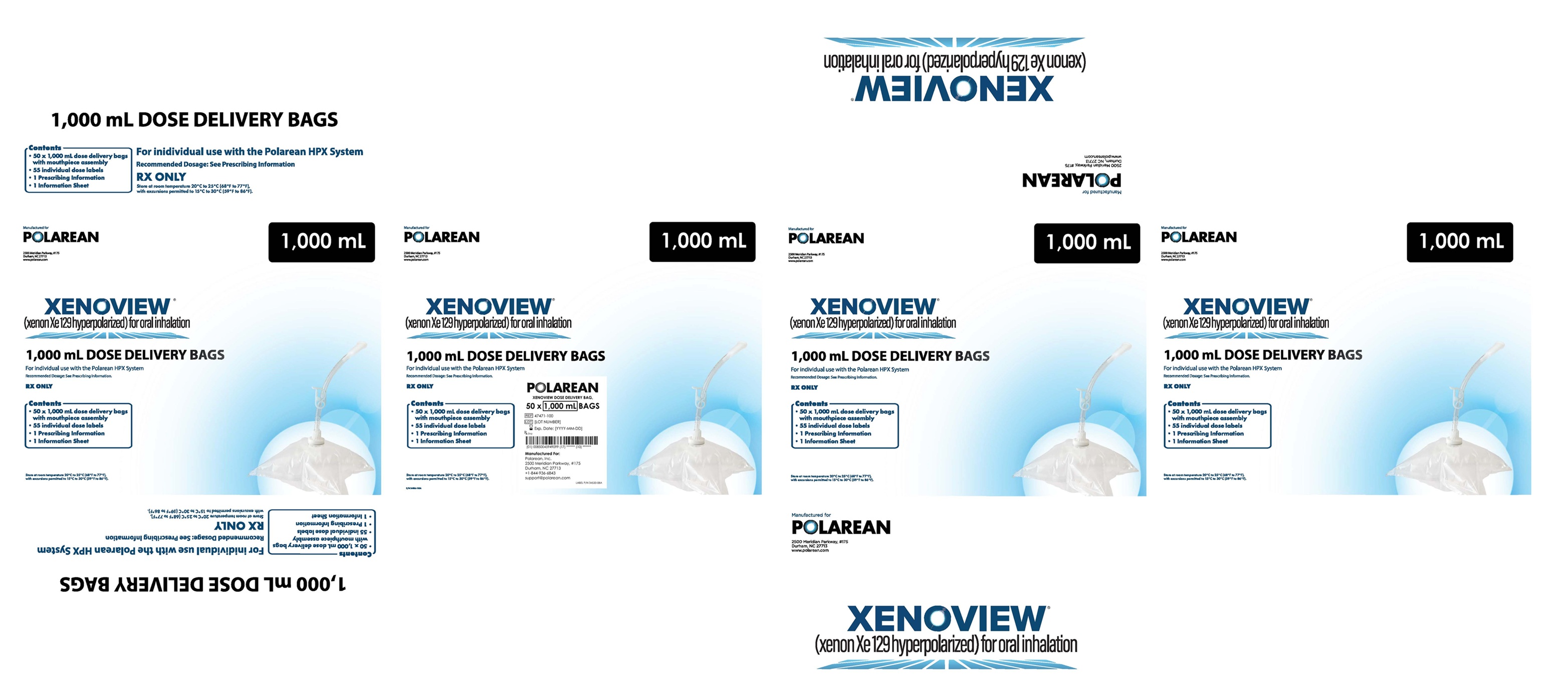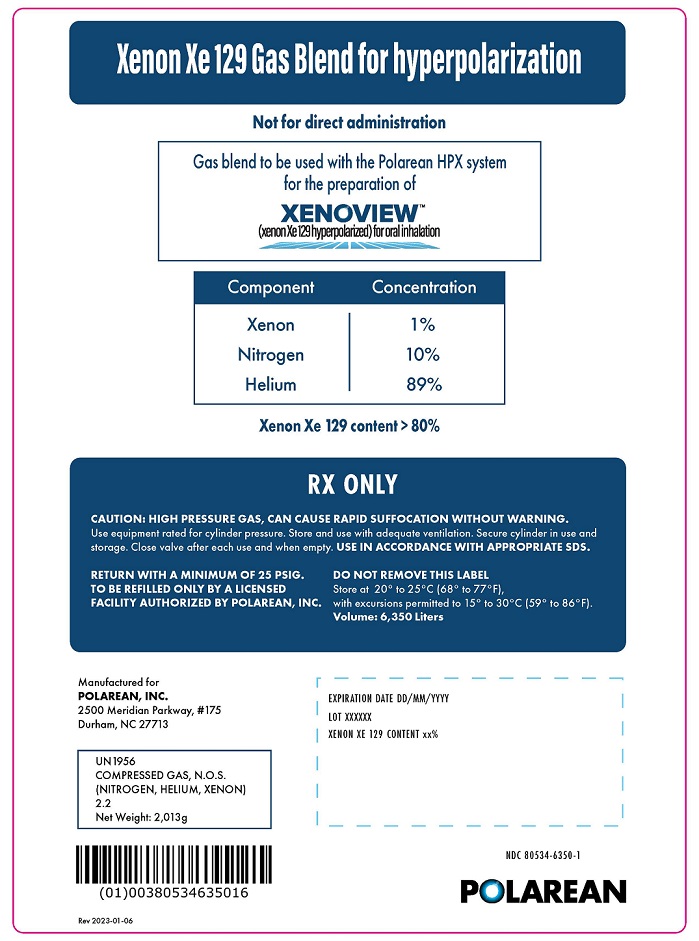Xenoview: Package Insert / Prescribing Info
Package insert / product label
Generic name: xenon xe 129 hyperpolarized gas
Dosage form: respiratory inhalation
Drug class: Diagnostic radiopharmaceuticals
Medically reviewed by Drugs.com. Last updated on Jun 23, 2025.
On This Page
Highlights of Prescribing Information
These highlights do not include all the information needed to use XENOVIEW® safely and effectively. See full prescribing information for XENOVIEW.
XENOVIEW (xenon Xe 129 hyperpolarized), for oral inhalation
Initial U.S. Approval: 2022
Recent Major Changes
Indications and Usage for Xenoview
XENOVIEW, prepared from the Xenon Xe 129 Gas Blend, is a hyperpolarized contrast agent indicated for use with magnetic resonance imaging (MRI) for evaluation of lung ventilation in adults and pediatric patients aged 6 years and older.
Limitations of Use
XENOVIEW has not been evaluated for use with lung perfusion imaging. (1)
Xenoview Dosage and Administration
- The recommended target dose of XENOVIEW for adult and pediatric patients aged 6 years and older is 75 mL to 100 mL Dose Equivalent (DE) volume of hyperpolarized xenon Xe 129 by oral inhalation of the entire contents of one XENOVIEW Dose Delivery Bag. (2.1)
- Choose an appropriate size of the Dose Delivery Bag based on patient’s Total Lung Capacity (TLC) or Forced Vital Capacity (FVC). (2.1)
- Administer dose within 5 minutes of DE measurement. (2.2)
- Initiate imaging immediately after inhalation. (2.2)
- See Full Prescribing Information for detailed information regarding preparation, administration, image acquisition, and image interpretation. (2.2, 2.3)
Dosage Forms and Strengths
- XENOVIEW is a clear, colorless, odorless gas contained in a XENOVIEW Dose Delivery Bag. The bag contains at least 75 mL DE of hyperpolarized xenon Xe 129 in a volume of 250 mL to 750 mL total xenon. The bag total volume administered is 300 mL, 500 mL, 750 mL, or 1,000 mL.
- The dosage strength is DE per volume administered. The minimum DE for a dose of XENOVIEW is 75 mL with a recommended DE target range of 75 mL to 100 mL. DE of greater than 100 mL is acceptable. (3)
Contraindications
None. (4)
Warnings and Precautions
- Risk of Decreased Image Quality from Supplemental Oxygen: Supplemental oxygen administered simultaneously with XENOVIEW inhalation can cause degradation of image quality. For patients on supplemental oxygen, withhold oxygen inhalation for two breaths prior to XENOVIEW inhalation, and resume oxygen inhalation immediately following the imaging breath hold. (5.1)
-
Risk of Transient Hypoxia: Inhalation of an anoxic gas such as XENOVIEW may cause transient hypoxemia in susceptible patients. Monitor all patients for oxygen saturation and symptoms of hypoxemia, and treat as clinically indicated. (5.2)
Adverse Reactions/Side Effects
The adverse reactions (> one patient) in efficacy trials in adults were oropharyngeal pain, headache, and dizziness. (6.1)
To report SUSPECTED ADVERSE REACTIONS, contact Polarean, Inc. at 1‑844-936-6843 or FDA at 1-800-FDA-1088 or www.fda.gov/medwatch.
Revised: 5/2025
Full Prescribing Information
1. Indications and Usage for Xenoview
XENOVIEW®, prepared from the Xenon Xe 129 Gas Blend, is indicated for use with magnetic resonance imaging (MRI) for evaluation of lung ventilation in adults and pediatric patients aged 6 years and older.
Limitations of Use
XENOVIEW has not been evaluated for use with lung perfusion imaging.
2. Xenoview Dosage and Administration
2.1 Recommended Dosage
The recommended target dose of XENOVIEW for adults and pediatric patients aged 6 years and older is 75 mL to 100 mL Dose Equivalent (DE) volume of hyperpolarized xenon Xe 129 by oral inhalation of the entire contents of one XENOVIEW Dose Delivery Bag.
Each bag contains at least 75 mL DE of hyperpolarized xenon Xe 129 measured within 5 minutes of administration, in a volume of 250 mL to 750 mL total xenon with additional nitrogen, NF (99.999% purity) added to reach a total volume of the Dose Delivery Bag.
Select the Dose Delivery Bag based on the patient’s Total Lung Capacity (TLC) according to Table 1. If TLC is not available at the time of the procedure, select the Dose Delivery Bag based on patient’s Forced Vital Capacity (FVC). If neither TLC nor FVC values are available in the patient’s medical records, select the Dose Delivery Bag based on estimates of the patient’s TLC using American Thoracic Society (ATS)-endorsed plethysmography-based predictive equations based on sex and height.
| TLC (L) | FVC†(L) | Dose Delivery Bag (mL) |
| <2.0 | <1.5 | 300 |
| 2.0 to <3.3 | 1.5 to <2.5 | 500 |
| 3.3 to <5.0 | 2.5 to <3.8 | 750 |
| ≥5.0 | ≥3.8 | 1,000 |
| †FVC is used when TLC is not available. | ||
The minimum DE for a dose of XENOVIEW is 75 mL with a recommended DE target range of 75 mL to 100 mL. DE of greater than 100 mL is acceptable.
DE is the volume (mL) of 100% isotopically enriched, 100% hyperpolarized, xenon Xe 129 that would produce the equivalent net magnetization as the Xe 129 dose. The HPX Polarization Measurement Station measures DE. DE is defined by the following formula:
DE = (total volume xenon gas) × (fraction of xenon Xe 129 isotopic enrichment in the xenon gas) × (fraction of hyperpolarization)
where the total volume of xenon gas is 250 mL to 750 mL, the fraction of xenon Xe 129 isotopic enrichment is > 80% and the mean fraction of hyperpolarization is no less than 38% to 54% at the completion of polarization of 250 mL of xenon gas.
For example, if 300 mL of total xenon gas with 83% enrichment of xenon Xe 129 is dispensed from the HPX Hyperpolarizer at 40% hyperpolarization:
DE = 300 mL × 0.83 × 0.40 = 99.6 mL
2.2 Preparation, Administration, and Image Acquisition
Preparation
- Choose an appropriate Dose Delivery Bag according to Table 1 [see Dosage and Administration (2.1)].
- Prepare hyperpolarized xenon Xe 129 in the HPX Hyperpolarizer from the Xenon Xe 129 Gas Blend and add Nitrogen, NF (99.999% purity) as necessary to fill the remaining volume in the XENOVIEW Dose Delivery Bag, according to the HPX Hyperpolarization System Operator’s Manual.
- Measure the volume and DE in the XENOVIEW Dose Delivery Bag using the HPX Polarization Measurement Station no more than 5 minutes prior to administration. The DE measurement should be at least 75 mL. Do not use and discard the dose of XENOVIEW® if the volume is determined to be outside of the acceptable range or the DE is less than 75 mL.
- Administer dose within 5 minutes of DE measurement.
- Do not use and discard the dose of XENOVIEW 60 minutes after filling of Dose Delivery Bag.
Administration
- Administer XENOVIEW according to the directions provided in the HPX Hyperpolarization System Operator’s Manual, Administering XENOVIEW.
- Fit the patient with an FDA-cleared Xe 129 chest coil in accordance with the chest coil manufacturer’s instructions for use. The chest coil and MRI scanner must be connected and compatible with one another.
- Position the patient supine with arms either by their side or above their head. Perform conventional 1H localizer scan, position the desired Xe 129 slices, and prepare the Xe 129 scan.
- For patients on supplemental oxygen, withhold oxygen inhalation for two breaths prior to XENOVIEW inhalation, and resume oxygen inhalation immediately following the imaging breath hold.
- Attach the mouthpiece to the XENOVIEW Dose Delivery Bag.
- With the patient positioned in the MRI scanner, place the mouthpiece in the patient’s mouth and instruct the patient to completely inhale the contents of the XENOVIEW Dose Delivery Bag with a single inhalation.
- Instruct the patient to hold the inhaled breath (up to 15 seconds) during MR image acquisition.
Image Acquisition
- Once the patient has inhaled the full dose of XENOVIEW, begin MRI scanning immediately.
- Upon scan completion, instruct the patient to breathe normally.
- If the image quality is insufficient or if the patient was not able to sufficiently inhale the contents of the XENOVIEW Dose Delivery Bag, the scan can be repeated with a new dose of XENOVIEW.
3. Dosage Forms and Strengths
XENOVIEW, prepared from the Xenon Xe 129 Gas Blend by the HPX Hyperpolarizer, is a clear, colorless, odorless gas contained in a 300 mL, 500 mL, 750 mL or 1,000 mL XENOVIEW Dose Delivery Bag. Each bag contains at least 75 mL Dose Equivalent (DE) of hyperpolarized xenon Xe 129 in a volume of 250 mL to 750 mL total xenon and a total volume administered of 300 mL, 500 mL, 750 mL, or 1,000 mL.
The strength is DE per volume administered (see Table 2). The minimum DE for a dose of XENOVIEW® is 75 mL with a recommended DE target range of 75 mL to 100 mL. DE of greater than 100 mL is acceptable.
|
Dose Delivery |
Minimum Dose |
Total Volume | Minimum Dosage Strength* |
| 300 | 75 | 300 | 75 mL DE per 300 mL total volume |
| 500 | 75 | 500 | 75 mL DE per 500 mL total volume |
| 750 | 75 | 750 | 75 mL DE per 750 mL total volume |
| 1,000 | 75 | 1,000 | 75 mL DE per 1,000 mL total volume |
| *Minimum Dosage Strength = mL Minimum Dose Equivalent per mL Total Volume Administered | |||
5. Warnings and Precautions
5.1 Risk of Decreased Image Quality from Supplemental Oxygen
Supplemental oxygen administered simultaneously with XENOVIEW inhalation can cause degradation of image quality due to depolarization of XENOVIEW. For patients on supplemental oxygen, withhold oxygen inhalation for two breaths prior to XENOVIEW inhalation, and resume oxygen inhalation immediately following the imaging breath hold [see Dosage and Administration (2.2)].
5.2 Risk of Transient Hypoxia
Inhalation of an anoxic gas such as XENOVIEW may cause transient hypoxemia in susceptible patients [see Adverse Reactions (6.1)]. Monitor all patients for oxygen desaturation and symptoms of hypoxemia, and treat as clinically indicated.
6. Adverse Reactions/Side Effects
6.1 Clinical Trials Experience
Because clinical trials are conducted under widely varying conditions, adverse reaction rates observed in the clinical trials of a drug cannot be directly compared to rates in the clinical trials of another drug and may not reflect the rates observed in practice.
Adverse Reactions in Adult Patients
The safety of XENOVIEW was evaluated in two prospective efficacy trials that enrolled a total of 83 adult patients with various lung disorders who were being evaluated for possible lung surgery [see Clinical Studies (14)]. Mean age of these patients was 62 years, 88% were White and 69% were male. In these two trials, mean xenon gas volume per XENOVIEW dose was 330.2 mL and 81 of 83 patients (98%) received a single administration of XENOVIEW. For safety assessment, the volume of administered xenon gas in the XENOVIEW dose is noted rather than the DE, because isotopic enrichment and hyperpolarization are not known to affect the safety profile of xenon gas.
Adverse reactions were reported in 12 (14%) of the 83 patients. Adverse reactions reported by more than one patient were oropharyngeal pain (n = 4 patients), headache (n = 2 patients), and dizziness (n = 2 patients).
A hypersensitivity reaction that included transient pruritus and erythema occurred in one patient with a history of allergic reactions to several drugs, foods, and other substances.
In pooled data of 123 adult patients from published studies, most of whom had lung disorders such as COPD, idiopathic pulmonary fibrosis, and asthma, who received 1 dose to 2 doses of hyperpolarized xenon Xe 129 with xenon volumes of approximately 500 mL to 1,000 mL of xenon gas per dose, the following transient adverse reactions were reported: numbness, tingling, euphoria, and dizziness. Overall frequency of these adverse reactions could not be determined from the published information.
Adverse Reactions in Pediatric Patients
In pooled data of 120 pediatric patients aged 6 to 18 years from published studies, most of whom had either asthma or cystic fibrosis, who received 1 dose to 2 doses of hyperpolarized xenon Xe 129 with xenon volumes based on predicted TLC, the following transient adverse reactions were reported: blood oxygen desaturation, heart rate elevation, numbness, tingling, dizziness, and euphoria. Overall frequency of these adverse reactions could not be determined from the published information.
In one of the published studies of 23 pediatric patients aged 6 to 18 years, 11 of whom had cystic fibrosis and 12 of whom were healthy, the mean difference of SpO2% from baseline was -6% following hyperpolarized xenon Xe 129 administration with xenon volumes based on predicted total lung capacity. In the same study, the mean change in heart rate from baseline was +6.6 beats per minute following hyperpolarized xenon Xe 129 administration. Both reported oxygen desaturation and heart rate elevation resolved by 2 minutes post-dose without intervention.
Related/similar drugs
8. Use In Specific Populations
8.1 Pregnancy
Risk Summary
XENOVIEW is minimally absorbed systemically following the inhalation route of administration, and maternal use is not expected to result in fetal exposure to the drug [see Clinical Pharmacology (12.3)]. Adequately designed animal reproduction studies have not been conducted with hyperpolarized xenon Xe 129. Although not adequately designed to evaluate reproductive and developmental toxicity, there are animal reproduction data available in the literature. Animal reproduction studies were conducted in rats by administering an 80% Xe/20% O2 gas mixture for 2 hours twice a week for 2 and 10 weeks, with no observed effects on fertility or pregnancy. Gas mixtures containing 70% to 75% Xe gas and 25% to 30% O2 gas were found to be non-teratogenic in rats when administered for 24 hours. In a separate study, rats were administered an 80%/20% Xe/O2 gas mixture for 2 hours twice a week from the first to nineteenth day of pregnancy with no observed effects on embryo-fetal development or signs of teratogenicity.
The background risk of major birth defects and miscarriage for the indicated population is unknown. All pregnancies have a background risk of birth defect, loss, or other adverse outcomes. In the U.S general population, the estimated background risks of major birth defects and miscarriage in clinically recognized pregnancies are 2% to 4% and 15% to 20%, respectively.
8.2 Lactation
Risk Summary
XENOVIEW® is minimally absorbed systemically following the inhalation route of administration, and breastfeeding is not expected to result in exposure of the infant to the drug [see Clinical Pharmacology (12.3)]. There is no information on the presence of hyperpolarized xenon Xe 129 in human milk, the effect on the breastfed infant, or the effect on milk production. The developmental and health benefits of breastfeeding should be considered along with the mother’s clinical need for XENOVIEW® and any potential adverse effects on the breastfed child from XENOVIEW or from the underlying maternal condition.
8.4 Pediatric Use
The safety and effectiveness of XENOVIEW have been established in pediatric patients aged 6 years and older for use with MRI to evaluate lung ventilation. Use of XENOVIEW in this age group is supported by evidence from adequate and well-controlled studies in adults with additional safety data from published studies [see Adverse Reactions (6.1) and Clinical Studies (14)].
Safety and effectiveness of XENOVIEW have not been established in pediatric patients less than 6 years of age.
8.5 Geriatric Use
Of the total number of patients in clinical studies of XENOVIEW, 36 (43%) were 65 years of age and older, while 6 (7%) were 75 years of age and older. No overall differences in safety or effectiveness have been observed between patients 65 years of age and older and younger adult patients although the number of patients in the trials was not large enough to allow definitive comparison.
11. Xenoview Description
XENOVIEW (xenon Xe 129 hyperpolarized) is a hyperpolarized contrast agent produced on site by the HPX Hyperpolarization System from the isotopically enriched Xenon Xe 129 Gas Blend. The Gas Blend cylinder distributed by Polarean contains xenon (1% total; > 80% isotopic purity Xe 129), nitrogen, NF (10%), and helium, NF (89%).
The active pharmaceutical ingredient in XENOVIEW is hyperpolarized xenon Xe 129. Hyperpolarized xenon Xe 129 is chemically identical to non-polarized xenon Xe 129. Xenon is a clear, colorless, monoatomic, inert, stable, noble gas. It is naturally abundant in air at a level of 0.087 ppm. Atmospheric xenon is composed of nine non-radioactive isotopes, of which xenon Xe 129 comprises 26.4%. The atomic weight of xenon Xe 129 is 128.9.
XENOVIEW is a clear, colorless, odorless gas for oral inhalation use. Each XENOVIEW Dose Delivery Bag contains a Dose Equivalent (DE) volume of hyperpolarized xenon Xe 129 in a volume of 250 mL to 750 mL total xenon with additional nitrogen, NF (99.999% purity) added as an inert buffer to ensure the total volume of gas reaches the dose delivery bag volume (300 mL, 500 mL, 750 mL, or 1,000 mL). The minimum DE for a dose of XENOVIEW is 75 mL with a recommended DE target range of 75 to 100 mL. DE of greater than 100 mL is acceptable.
12. Xenoview - Clinical Pharmacology
12.1 Mechanism of Action
When hyperpolarized xenon Xe 129 gas is inhaled, a multi-nuclear capable MRI scanner can be used to image the hyperpolarized xenon Xe 129 distribution throughout the ventilated lung. Hyperpolarized xenon Xe 129 nuclei are directly detected by a Xe 129 MRI coil.
12.2 Pharmacodynamics
The MRI signal of hyperpolarized xenon Xe 129 is dependent on the volume of the xenon gas inhaled, degree of xenon Xe 129 isotopic enrichment, and degree of hyperpolarization [see Dosage and Administration (2.1)].
12.3 Pharmacokinetics
The pharmacokinetics of hyperpolarized xenon Xe 129 are similar to those of non-polarized xenon.
Distribution
Xenon is a readily diffusible gas. Inhalation of xenon results in dispersion in the ventilated areas of the lung with uptake of a small amount of xenon into the pulmonary vessels followed by distribution to more distal organs. The solubility of xenon is higher in fatty tissues than in aqueous tissues and body compartments such as plasma.
Elimination
Following a single breath hold, xenon is eliminated through exhalation with an elimination half-life of 14.5 seconds for a 75% Xe/25% N2 gas mixture and 14.3 seconds for a 25% Xe/75% N2 gas mixture.
14. Clinical Studies
The safety and efficacy of XENOVIEW® were evaluated in two prospective, multi-center, randomized, open-label, cross-over clinical trials that compared XENOVIEW MRI to xenon Xe 133 scintigraphy in adult patients with pulmonary disorders: Study 1 (NCT03417687) and Study 2 (NCT03418090). The mean XENOVIEW dose used in these trials was 99 mL DE of hyperpolarized xenon Xe 129 at the time of measurement within 5 minutes of administration.
Study 1
Study 1 compared XENOVIEW and xenon Xe 133 imaging in patients being evaluated for possible lung resection surgery with respiratory disorders including: pulmonary mass (44%), COPD (35%), cough (15%), sleep apnea syndrome (12%), and asthma (12%). A total of 32 patients, with a mean age of 62 years (range 25 to 77 years) of whom 78% were White and 69% were male, completed both scans.
On each XENOVIEW and xenon Xe 133 scan, the fraction of total signal in the lungs was calculated in each of six zones consisting of upper, middle, and lower regions in each lung. These values were used to estimate the post-operative percentage of lung ventilation predicted to remain after planned resection of a pre-specified lung area.
One of the 32 patients who completed both scans was excluded from the primary analysis because no planned resection area was recorded. In the remaining 31 patients, the mean within-patient difference in the predicted post-operative percentage of remaining lung ventilation between XENOVIEW and xenon Xe 133 imaging was within a pre-specified equivalence interval with an observed estimate of 1.4% (95% confidence interval: -0.8%, 3.6%). In an exploratory analysis that standardized the within-patient difference of the predicted remaining lung ventilation between XENOVIEW and xenon Xe 133 imaging to each patient’s xenon Xe 133 results, the percentage of patients who had standardized differences within ± 10%, ± 15%, and ± 20% were 81% (25/31), 94% (29/31), and 94% (29/31), respectively.
Study 2
Study 2 compared XENOVIEW and xenon Xe 133 imaging in patients being evaluated for possible lung transplant surgery with respiratory disorders including: interstitial lung disease (49%), idiopathic pulmonary fibrosis (29%), COPD (22%), sleep apnea syndrome (16%), other pulmonary fibrosis (14%), allergic rhinitis (12%), and cough (10%). A total of 49 patients, with a mean age of 62 years (range 19 to 77 years), of whom 94% were White and 69% were male, completed both scans.
On each XENOVIEW® and xenon Xe 133 scan, right lung signal and total signal in the lungs were calculated and used to estimate the percentage of overall lung ventilation contributed by the right lung.
In the primary analysis of the 49 patients who completed both scans, the mean within-patient difference in the percentage of overall lung ventilation contributed by the right lung between XENOVIEW and xenon Xe 133 imaging was within a pre-specified equivalence interval with an observed estimate of 1.6% (95% confidence interval: -3.7%, 0.5%). In an exploratory analysis that standardized the within-patient difference of right lung ventilation between XENOVIEW and xenon Xe 133 imaging to that of each patient’s xenon Xe 133 results, the percentage of patients who had standardized differences of ± 10%, ± 15%, and ± 20% were 65% (32/49), 80% (39/49), and 96% (47/49), respectively.
16. How is Xenoview supplied
How Supplied
XENOVIEW (xenon Xe 129 hyperpolarized) is prepared from the Xenon Xe 129 Gas Blend by the HPX Hyperpolarizer and is contained in a XENOVIEW Dose Delivery Bag as a clear, colorless, odorless gas.
XENOVIEW Dose Delivery Bags are available in four different sizes co-packaged with attachable mouthpieces and affixable dose labels:
- 300 mL bags in a box of 50 (NDC 80534-0300-1)
- 500 mL bags in a box of 50 (NDC 80534-0500-1)
- 750 mL bags in a box of 50 (NDC 80534-0750-1)
- 1,000 mL bags in a box of 50 (NDC 80534-1000-2)
Xenon Xe 129 Gas Blend for preparation of XENOVIEW is supplied as a compressed gas under high pressure (2,105 pounds per square inch gauge [psig]) in size 302 aluminum cylinders with a volume of 6,350 liters (NDC 80534-6350-1).
Storage and Handling
Store XENOVIEW at 20° to 25°C (68° to 77°F) for no more than 5 minutes after final DE measurement. Do not use and discard XENOVIEW 60 minutes after filling of Dose Delivery Bag.
Store Xenon Xe 129 Gas Blend at 20° to 25°C (68° to 77°F), with excursions permitted to 15°C to 30°C (59°F to 86°F).
Manufactured for:
Polarean, Inc.
2500 Meridian Parkway, #175
Durham, NC 27713
Tel: +1-844-936-6843
XENOVIEW® is a trademark of Polarean, Inc.
Doc #: 34660D
PRINCIPAL DISPLAY PANEL - NDC 80534-0300-1
XENOVIEW Dose Delivery Bag (300 mL)
NDC 80534-0300-1
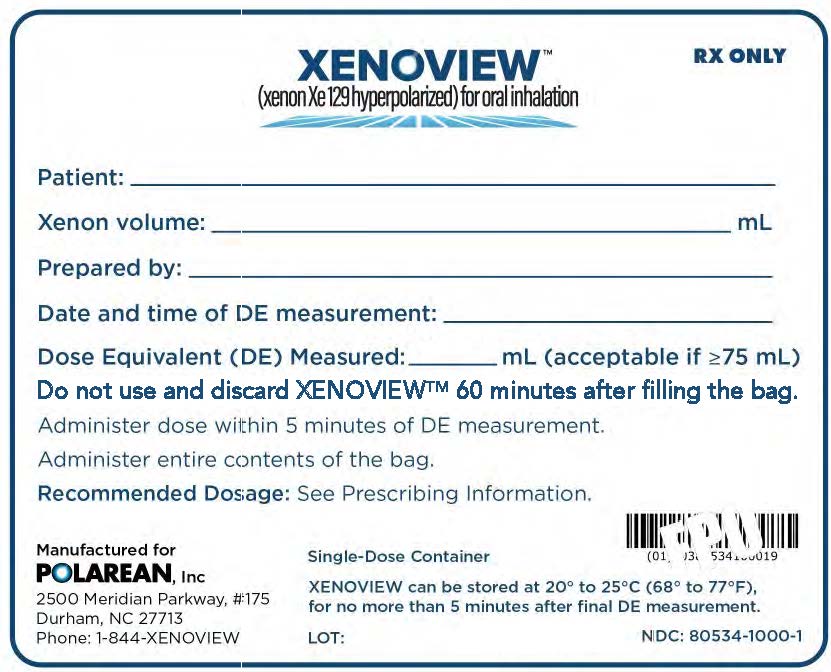
XENOVIEW Carton of Delivery Bags (50 bags with attachable mouthpieces and affixable dose labels)
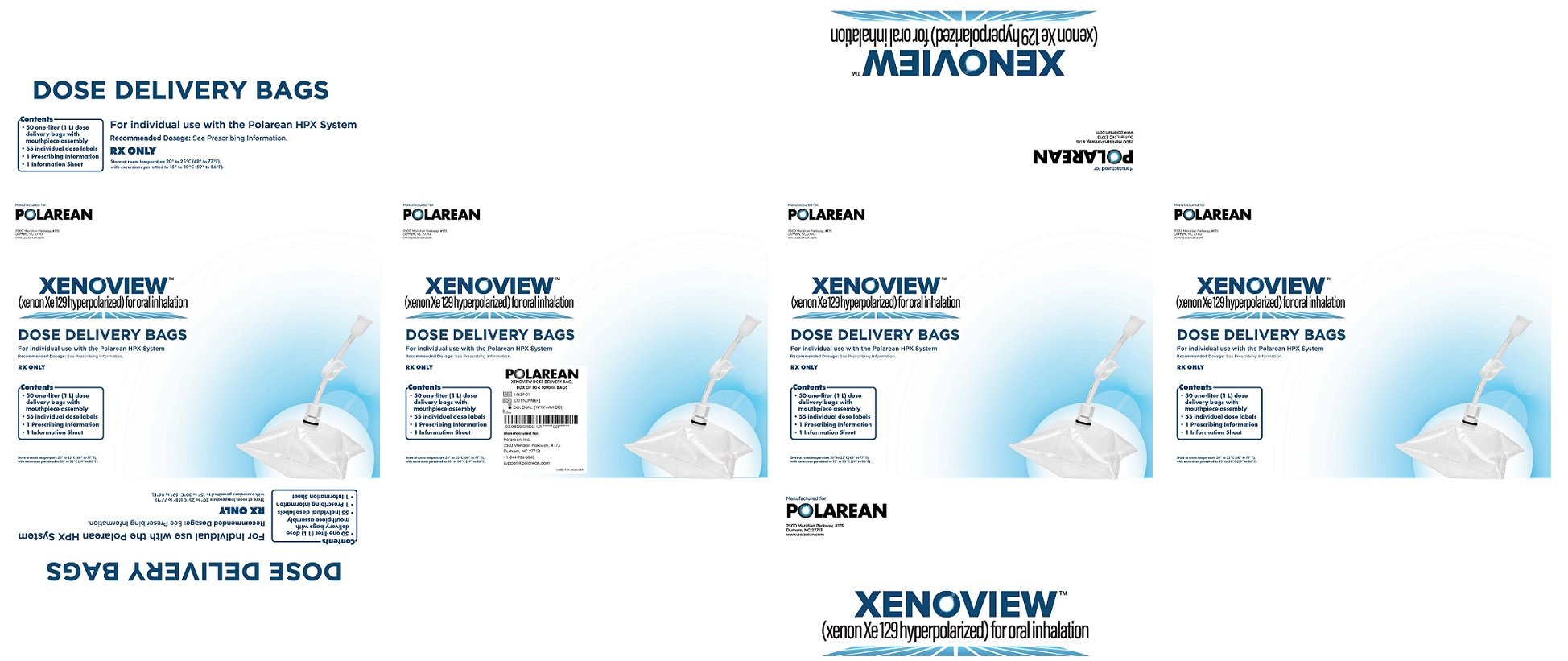
PRINCIPAL DISPLAY PANEL - NDC 80534-0500-1
XENOVIEW Dose Delivery Bag (500 mL)
NDC 80534-0500-1
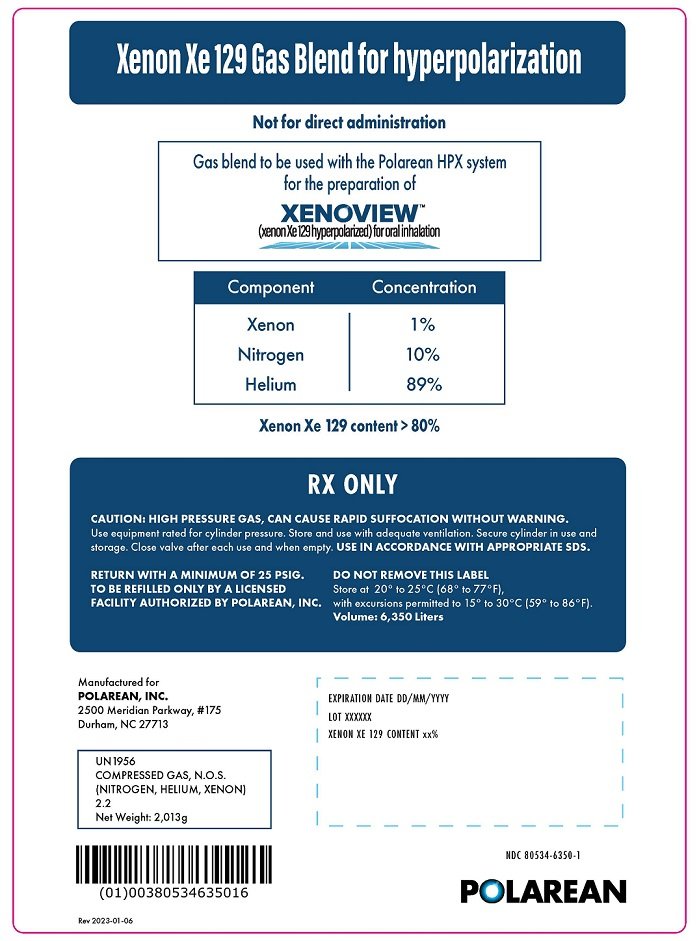
XENOVIEW Carton of Delivery Bags (50 bags with attachable mouthpieces and affixable dose labels)
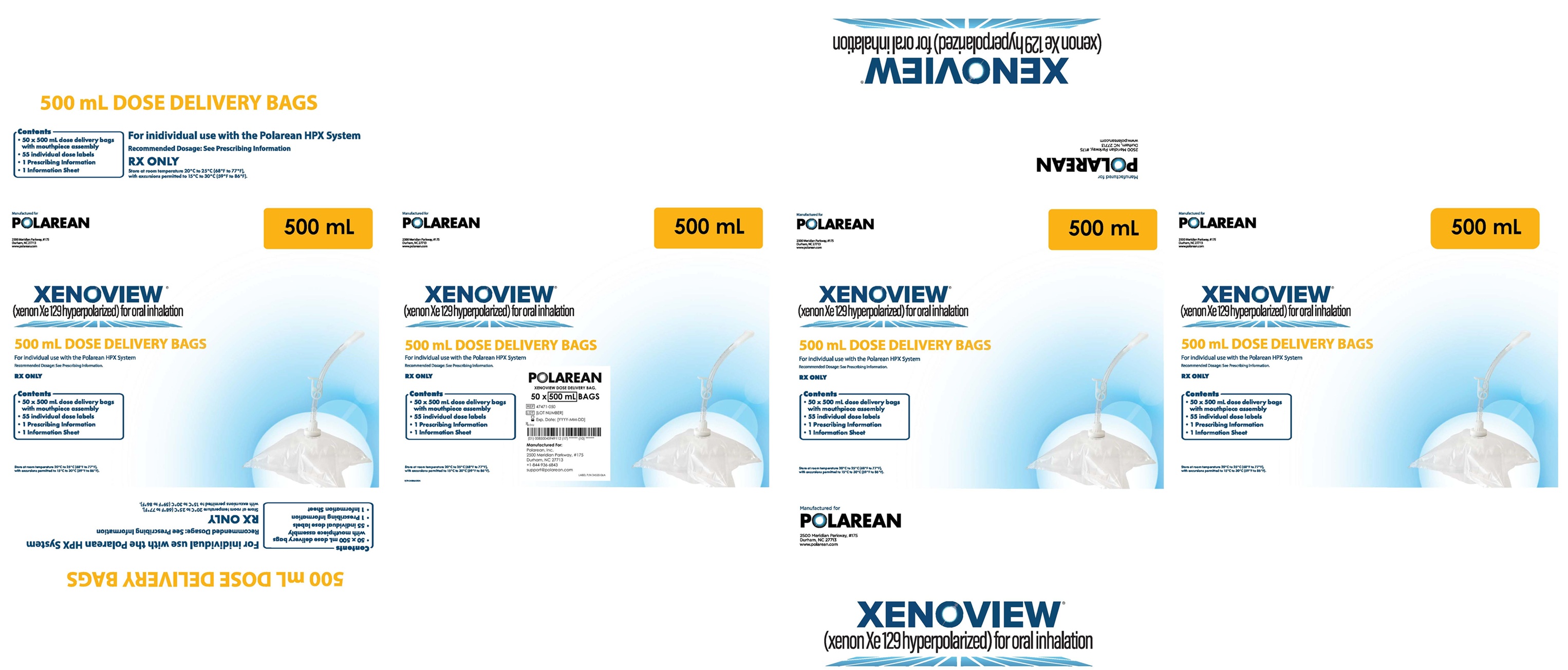
PRINCIPAL DISPLAY PANEL - NDC 80534-0750-1
XENOVIEW Dose Delivery Bag (750 mL)
NDC 80534-0750-1
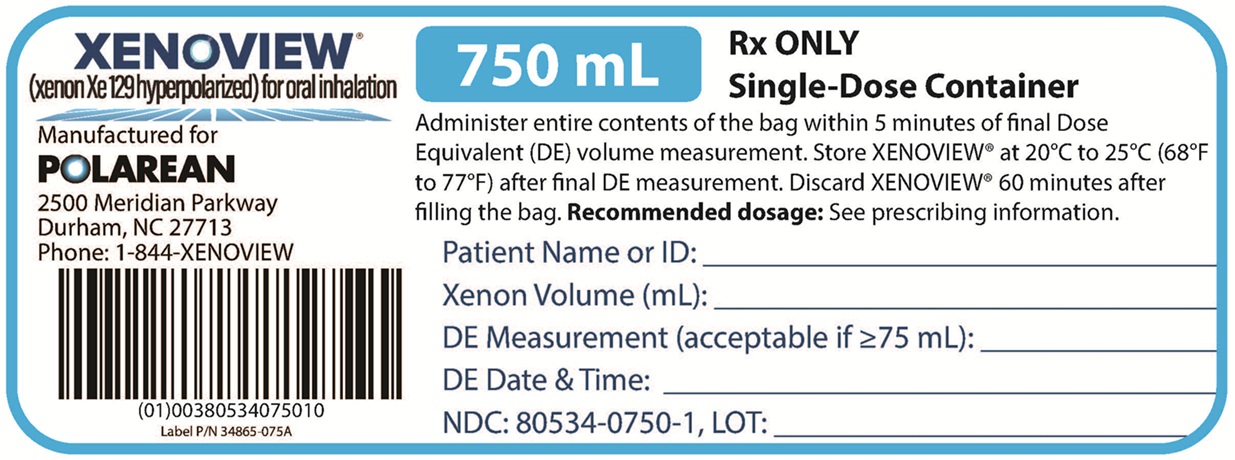
XENOVIEW Carton of Delivery Bags (50 bags with attachable mouthpieces and affixable dose labels)
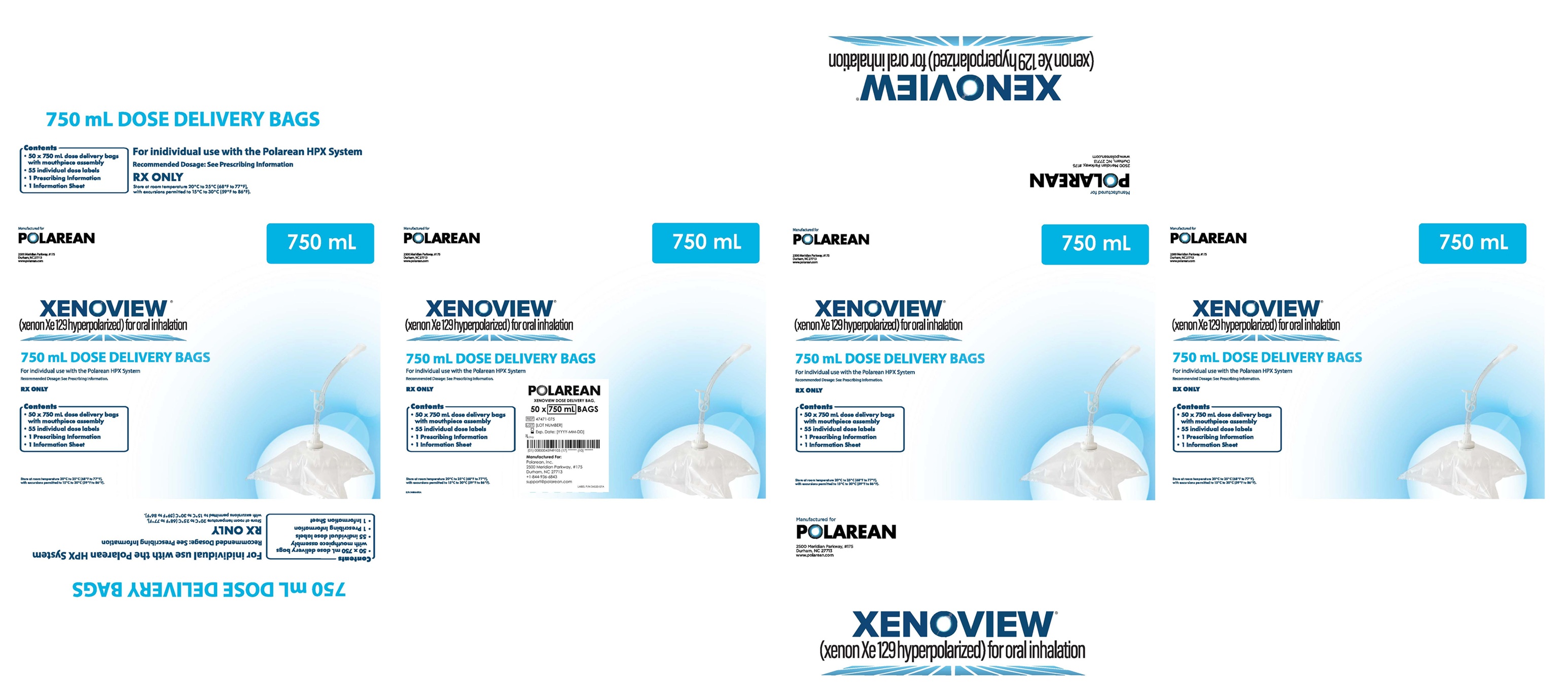
| XENOVIEW
xenon xe 129 hyperpolarized gas |
||||||||||||||||||||
|
||||||||||||||||||||
|
||||||||||||||||||||
|
||||||||||||||||||||
|
||||||||||||||||||||
| XENOVIEW
xenon xe 129 hyperpolarized gas |
||||||||||||||||||||
|
||||||||||||||||||||
|
||||||||||||||||||||
|
||||||||||||||||||||
|
||||||||||||||||||||
| XENOVIEW
xenon xe 129 hyperpolarized gas |
||||||||||||||||||||
|
||||||||||||||||||||
|
||||||||||||||||||||
|
||||||||||||||||||||
|
||||||||||||||||||||
| XENOVIEW
xenon xe 129 hyperpolarized gas |
||||||||||||||||||||||||||||||
|
||||||||||||||||||||||||||||||
|
||||||||||||||||||||||||||||||
|
||||||||||||||||||||||||||||||
|
||||||||||||||||||||||||||||||
| XENOVIEW
xenon xe 129 hyperpolarized gas |
|||||||||||||||
|
|||||||||||||||
|
|||||||||||||||
|
|||||||||||||||
|
|||||||||||||||
| Labeler - Polarean, Inc. (078629330) |
More about Xenoview (xenon xe 129 hyperpolarized)
- Compare alternatives
- Pricing & coupons
- Side effects
- Dosage information
- During pregnancy
- FDA approval history
- Drug class: diagnostic radiopharmaceuticals

